
Bubble tea is a tea-based drink. Originating in Taichung, Taiwan in the early 1980s, it includes chewy tapioca balls or a wide range of other toppings.

Taiwan, officially the Republic of China (ROC), is a country in East Asia. Neighbouring countries include the People's Republic of China (PRC) to the northwest, Japan to the northeast, and the Philippines to the south. The main island of Taiwan has an area of 35,808 square kilometres (13,826 sq mi), with mountain ranges dominating the eastern two-thirds and plains in the western third, where its highly urbanised population is concentrated. Taipei is the capital as well as the largest metropolitan area of Taiwan. Other major cities include New Taipei, Kaohsiung, Taichung, Tainan and Taoyuan. With 23.57 million inhabitants, Taiwan is among the most densely populated countries.
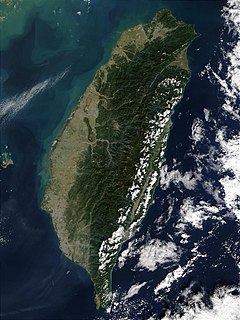
Taiwan, officially the Republic of China (ROC), is an island country in East Asia. The main island of Taiwan, known historically in English as Formosa, makes up 99% of the area controlled by the ROC, measuring 35,808 square kilometres (13,826 sq mi) and lying some 180 kilometres (112 mi) across the Taiwan Strait from the southeastern coast of mainland China. The East China Sea lies to its north, the Philippine Sea to its east, the Luzon Strait directly to its south and the South China Sea to its southwest. Smaller islands include a number in the Taiwan Strait including the Penghu archipelago, the Kinmen and Matsu Islands near the Chinese coast, and some of the South China Sea Islands.

The economy of Taiwan is a developed capitalist economy with most government firms being privatised. It is the seventh largest in Asia and 20th-largest in the world by purchasing power parity allowing Taiwan to be included in the advanced economies group by the International Monetary Fund and gauged in the high-income economies group by the World Bank. Taiwan is the most technologically advanced computer microchip maker in the world.
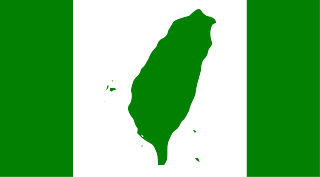
The Taiwan independence movement is a political movement to seek formal international recognition of Taiwan as an independent, sovereign nation and in opposition to Chinese unification.

Taiwanese indigenous peoples or formerly Taiwanese aborigines, Formosan people, Austronesian Taiwanese or Gāoshān people, are the indigenous peoples of Taiwan, who number almost 569,008 or 2.38% of the island's population—or more than 800,000 people, considering the potential recognition of Taiwanese plain indigenous peoples officially in the future. Recent research suggests their ancestors may have been living on Taiwan for approximately 5,500 years in relative isolation before major Han (Chinese) immigration from mainland China began in the 17th century. Taiwanese indigenous peoples are Austronesian peoples, with linguistic and genetic ties to other Austronesian peoples. Related ethnic groups include Polynesians, most people of the Philippines, Indonesia, Malaysia and Brunei, among others. The demographic proportion in Singapore is similar to Taiwan, with the Han Chinese making up a majority of the population at 76% and the Austronesian (Malays) a minority, albeit at a higher percentage of 15% with other races making up the difference. The consensus among the scientific community point to Polynesians also having originated from the indigenous Taiwanese through linguistic and genetic ties.
Mainland China, also known as the Chinese mainland, is the geopolitical and geographical area under the direct jurisdiction of the People's Republic of China (PRC). It includes Hainan, which is an island province in the South China Sea, but it excludes the special administrative regions of Hong Kong and Macau, even though both are mostly on the geographic continental landmass.

Taipei, officially Taipei City, is the capital and a special municipality of Taiwan. Located in Northern Taiwan, Taipei City is an enclave of the municipality of New Taipei City that sits about 25 km (16 mi) southwest of the northern port city of Keelung. Most of the city rests on the Taipei Basin, an ancient lakebed. The basin is bounded by the relatively narrow valleys of the Keelung and Xindian rivers, which join to form the Tamsui River along the city's western border.
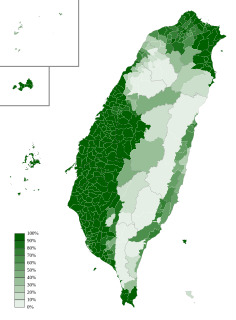
Taiwanese Hokkien, also known as Taiwanese Minnan, Holo, Taiwanese, or Taigi, is a variety of the Hokkien language spoken natively by about 70 % of the population of Taiwan. It is spoken by the Taiwanese Hoklo people, who descended from immigrants from southern Fujian during the Qing dynasty. The Pe̍h-ōe-jī (POJ) romanization is a popular orthography for Taiwanese Hokkien.
The controversy regarding the political status of Taiwan, sometimes referred to as the Taiwan Issue or Taiwan Strait Issue, or from a Taiwanese perspective as the Mainland Issue, is a result of the Chinese Civil War and the subsequent split of China into the two present-day self-governing entities of the People's Republic of China and the Republic of China.
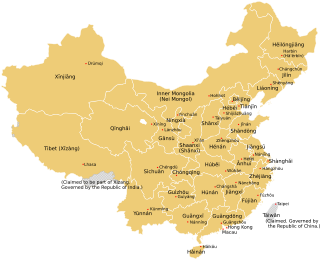
Provincial-level administrative divisions or first-level administrative divisions, are the highest-level Chinese administrative divisions. There are 34 such divisions claimed by the People's Republic of China, classified as 23 provinces, four municipalities, five autonomous regions, and two Special Administrative Regions. The political status of Taiwan Province along with a small fraction of Fujian Province remain in dispute, those are under separate rule by the Republic of China.
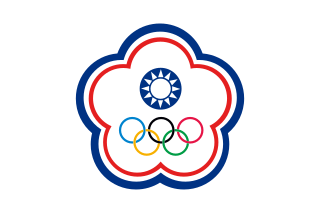
"Chinese Taipei" is the name used in some international organizations and competitions for Taiwan. This name was first proposed in the Nagoya Resolution whereby the ROC/Taiwan and the People's Republic of China (PRC) recognize the right of participation to each other when it comes to the activities of the International Olympic Committee and its correlates. The ROC participates under this name in various international organizations and events, including the World Trade Organization, the World Health Organization, the Metre Convention, and international pageants.
The New Taiwan dollar is the official currency used in Taiwan. Formally, one dollar (圓) is divided into ten dimes (角), and to 100 cents (分), although cents are never used in practice. The New Taiwan dollar has been the currency of Taiwan since 1949, when it replaced the Old Taiwan dollar, at a rate of 40,000 old dollars per one new dollar.

Chinese people are the various individuals or ethnic groups associated with China, usually through ancestry, ethnicity, nationality, citizenship, or other affiliation.

The Republic of China Navy, also known as the Taiwan Navy is the maritime branch of the Republic of China Armed Forces. The ROC Navy's primary mission is to defend ROC territories and the sea lanes that surround Taiwan against a blockade, attack, or possible invasion by the People's Liberation Army Navy of the People's Republic of China. Operations include maritime patrols in the Taiwan Strait and surrounding waters, as well as counter-strike and counter-invasion operations during wartime. The Republic of China Marine Corps functions as a branch of the Navy.

Tsai Ing-wen is a Taiwanese politician and academic serving as the seventh president of the Republic of China (Taiwan), since 2016. A member of the Democratic Progressive Party, Tsai is the first female president of Taiwan. She has served as Chair of the Democratic Progressive Party (DPP) since 2020, and previously from 2008 to 2012 and 2014 to 2018.
Taiwanese people are people from Taiwan who share a common culture, ancestry, and speak Taiwanese Mandarin, Hokkien, Hakka, or indigenous Taiwanese languages as a mother tongue. Taiwanese people may also refer to individuals who are ascribed cultural identity from areas under the control of the Government of Taiwan since 1945, including Penghu, Kinmen, and Matsu islands. At least three competing paradigms are used to identify someone as a Taiwanese person: nationalist criteria, self-identification criteria, and socio-cultural criteria. These standards are fluid, and result from evolving social and political issues. The complexity resulting from competing and evolving standards is compounded by a larger dispute regarding Taiwan's identity, the political status of Taiwan, and its potential de jure Taiwan independence or Cross-Strait Unification.

Japanese Taiwan was the period of Taiwan and the Penghu Islands under Japanese rule between 1895 and 1945.

Hokkien or Minnan (閩南語/闽南语), known as Quanzhang or Tsuan-Tsiang (泉漳) in linguistics, is a Southern Min language originating from the Minnan region in the south-eastern part of Fujian Province in Southeastern China and spoken widely there. It is also spoken widely in Taiwan, where it is usually known as Taiwanese or Holo, and by the Chinese diaspora in Malaysia, Singapore, Indonesia, the Philippines and other parts of Southeast Asia and by other overseas Chinese all over the world.

The COVID-19 pandemic in Taiwan is part of the worldwide pandemic of coronavirus disease 2019 caused by severe acute respiratory syndrome coronavirus 2. The pandemic has had a much smaller impact in Taiwan than in most other industrialized countries, with a total of seven deaths as of 11 May 2020. The number of active cases peaked on 6 April at 307 cases, the overwhelming majority of which were imported.
















